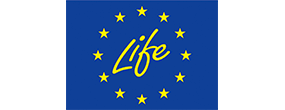Overview
Final energy consumption in 2022, corrected for temperature variations, was about 40 Mtoe (see Figure 1). The figure also shows energy consumption in 2019, the latest 'normal' year, i.e. before the Covid epidemic starting in 2020 that had a large impact on transport volume and before the very high energy prices due to the war in Ukraine. The consumption in all sectors was lower in 2022 than in 2019. Not all of this reduction was due to energy efficiency as we will see later. The much lower energy consumption in the agriculture sector, that is dominated by horticulture, was a result of the high energy prices in 2022.
Figure 1: Final energy consumption by sector (with climatic corrections)
Source: ODYSSEEEfficiency for total final energy consumption, as measured by the so-called technical ODEX, has improved by around 1.6% per year since 2000. This can be derived from the value if 70 of the total ODEX in 2022 shown in Figure 2. Smaller than average annual gains have been achieved in services (1.1%/year) and especially in transport (0.3%/year), larger gains were achieved in the residential sector (2.4%/year) and in industry (2.2%/year). The highest efficiency improvement since 2019 thus occurred in the households sector, which was caused by the high energy prices towards the end of 2021 and in 2022.
Figure 2: Technical Energy Efficiency Index
Source: ODYSSEEFigure 3 shows that cumulative annual energy savings have also been highest in the residential sector and in industry. In the residential sector this was mainly the result of high efficiency boilers and insulation measures. In industry, the results may be distorted by the fact that in the chemical industry, which uses more than half of the final energy in Dutch manufacturing, the industrial production index IPI (based on changes in added value) is used as the production volume. This means that energy savings in the chemical industry seem to improve when higher value products are produced. Again, it is quite clear energy savings in transport stay far behind.
Figure 3: Energy savings by sector
Source: OdysseeTotal energy supply decreased by 10.6 Mtoe between 2000 and 2022. Figure 4 shows that this was the result of a lower final energy consumption (-8.3 Mtoe), lower consumption of the power sector (-1.3 Mtoe) and lower non-energy use (-1 Mtoe). The lower power sector consumption was the result of opposite trends: higher power consumption (3.1 Mtoe), a shift from net import to export of electricity (2 Mtoe) and a less efficient fuel mix in thermal power plants (a higher share of biomass, 1.4 Mtoe). This was more than mitigated by a higher share of wind and solar (-3.7 Mtoe) and a higher efficiency of thermal power plants (-4 Mtoe).
Figure 4: Main drivers of the total energy supply variation
Source: OdysseeDespite an increase of energy consuming activities and a shift to a more energy-intensive structure of the economy, the total final energy consumption decreased by over 8 Mtoe between 2000 and 2022, as can be seen in Figure 5. Energy savings more than compensated the increasing effect of activities and structure, and "other" effects, which include behavioural change, also led to a lower energy consumption.
Figure 5: Main drivers of the final energy consumption variation
Source: OdysseeThe Netherlands aims to be part of a climate-neutral Europe in 2050. In order to achieve climate-neutrality in 2050, the Dutch national interim target for 2030 has been tightened to at least a 55% net greenhouse gas reduction in 2030 compared to 1990. To ensure that this target is achieved, it has been agreed to focus policy on a higher target of approximately 60% in 2030. This policy is elaborated in the Climate Policy Program that was published in June 2022 and the additional policy package that the cabinet agreed on in April 2023 ("Voorjaarsbesluitvorming Klimaat").
Many of the current and proposed greenhouse gas mitigation measures will stimulate energy efficiency. However, for the Netherlands, energy efficiency will also be directly addressed through the implementation of the revised EU Energy Efficiency Directive (EED). As part of the Fit for 55 agreement, the EED makes it binding for EU countries to collectively ensure an additional 11.7% reduction in energy consumption by 2030, compared to the 2020 reference scenario projections. The Dutch government is developing indicative sectoral target values for energy savings in order to fulfil its national contribution towards this goal.
Some general measures with high impact are described in the table below.
Table 1: Sample of cross-cutting measures
| Measures | NECP measures | Description | Expected savings, impact evaluation | More information available |
|---|---|---|---|---|
| Climate Policy Programme (Beleidsprogramma Klimaat) | Yes | This policy program contains the main lines of climate policy including 2030 – aimed at realisation of the targets from the Climate Act. | High | Link |
| Energy taxes and surcharges | Yes | The energy tax is levied on electricity and natural gas, and the level depends on the level of energy consumption of a customer (degressive tariff structure). | High | Link |
| EIA: Energy Investment Allowance (NL: Energie-investeringsaftrek) | Yes | Deduction scheme from fiscal profits to promote investments in new energy efficient technologies. | High | Link |
Buildings
As can be seen in Figure 6, the energy consumption of the built environment decreased between 2010 and 2022; it increased between 2000 and 2010 because of more energy use in the services sector. In contrast, the consumption in the households sector showed a more consistent decreasing trend between 2000 and 2022.
Figure 6: Final energy consumption in buildings (with climatic corrections)
Source: ODYSSEEFigure 7 shows that the large majority of energy consumption reduction in households was achieved in space heating. Electrical appliances used more than in 2000, lighting and cooking less.
Figure 7: Energy consumption by end-use of households (with climatic corrections)
Source: ODYSSEEThe energy used for space heating per square meter in households has decreased steadily until 2015 as is visible in Figure 8. A large part of the reduction is due to better insulation and a grown share of high efficiency condensing boilers. Between 2015 and 2021, energy consumption per square meter remained roughly at the same level. The decrease in 2022 is related to the high energy prices in late 2021 and 2022, which was related to the war in Ukraine. This led to more economical heating behaviour.
Figure 8: Energy consumption of household space heating per m2 (with climatic corrections)
Source: ODYSSEE; ambient heat included.The reduction of energy consumption per dwelling for other uses than space heating is depicted in Figure 9. The energy used for water heating has decreased consistently between 2000 and 2022, the consumption by electrical appliances and lighting decreased after 2012 despite a higher number of electrical appliances because of increased efficiency. The improved efficiency of appliances can for a large part be attributed to the Ecodesign directive.
Figure 9: Energy consumption per dwelling by end-use (except space heating)
Source: ODYSSEEThe different uses of electricity consumption per dwelling are shown in Figure 10. Electrical appliances use the majority of electricity. They have become consistently more efficient since 2000, especially after the introduction of the Ecodesign directive, as has lighting. Thermal use has gone up because of a larger number of heat pumps, and in later years more air conditioners.
Figure 10: Electricity consumption per dwelling by end-use (with climatic corrections)
Source: ODYSSEEFigure 11 shows that the total energy consumption in the households sector has decreased between 2000 and 2022, despite the fact that there were more dwellings, more appliances per dwelling and homes became larger. All these effects were more than compensated by energy savings, mainly by insulation and more efficient heating systems. 'Other' effects also lowered energy consumption. These combine two opposite effects: a reduction due to more economical heating behavior (-1.23 Mtoe), especially linked to higher energy prices towards the end of 2021 and in 2022, and an increase due the ambient heat of heat pumps (+0.27 Mtoe).
Figure 11: Main drivers of the energy consumption variation in households
Source: ODYSSEE; ambient heat included.Figure 12 shows the same decomposition pattern of energy use for space heating in dwellings as Figure 11 shows for the total energy consumption. This is an indication of the fact that space heating dominates energy consumption in dwellings as well as energy savings.
Figure 12: Main drivers of the space heating consumption variation of households
Source: ODYSSEE; ambient heat included.Energy consumption in the services sector decreased after 2010, as reflected in Figure 13. Energy use of private offices and education remained more or less stable since 2014. The consumption in the health and wholesale sectors decreased steadily since 2014. The consumption in hotels and restaurants is the exception with a slightly increasing energy consumption trend since 2014.
Figure 13: Final energy consumption of services by branch
Source: ODYSSEEThe total energy consumption per square meter in the services sector decreased while that of electricity increased, as can be seen in Figure 14. This is because savings in space heating by insulation and more efficient heating had a larger effect than the increased electricity consumption.
Figure 14: Energy and electricity consumption per m² in services (with climatic corrections)
Source: ODYSSEEIn line with the Netherlands' broader energy and climate policy, the sustainability of the built environment is primarily focused on CO2 reduction. The current target for the built environment, agreed to as part of a policy package in April 2023 ("Voorjaarsbesluitvorming Klimaat") is an emission ceiling of 13.2 Mt of CO2-equivalents in 2030.
The core of the Dutch approach in the built environment is reducing energy demand through behaviour, insulation and hybrid heat pumps, and developing sustainable heat sources to meet the remaining demand. This happens via multiple tracks simultaneously: both through an area-oriented approach via municipalities (based on heat transition visions, district implementation plans, and energy fix teams in response to energy poverty) and with policy for individual homes and buildings (on topics such as energy labelling, nearly zero-emission buildings, public building renovation).
Some measures with high impact in the built environment are described in the table below.
Table 2: Sample of policies and measures implemented in the building sector
| Measures | NECP measures | Description | Expected savings, impact evaluation | More information available |
|---|---|---|---|---|
| National Heat Fund (Nationaal Warmtefonds) | Yes | The National Heat Fund (Nationaal Warmtefonds) is a revolving fund for heat projects and other sustainability measures for owner-occupants and homeowners’ associations. It follows up on the earlier national energy loan fund possibilities (NEF). The terms and conditions for citizens were revised a number of times and owners’ associations were also included in order to boost the fund. | High | Link |
| Investment Subsidy for Sustainable Energy (ISDE) (NL: Investeringssubsidie Duurzame Energie) | Yes | Households and small commercial users can apply for an allowance for the purchase of heat pumps, biomass boilers, solar water heaters, pellet stoves and small wood-fired boilers. | High | Link |
| Energy saving & reporting obligation | Yes | Companies that consume in excess of 50 000 kWh of energy or 25 000 m3 of gas are required to adopt energy saving measures with a payback time of 5 years or less. Since 2019, a mandatory reporting of measures taken was introduced (Informatieplicht) | High | Link |
Transport
The energy consumption by cars and its share in total energy consumption of domestic transport as depicted in Figure 15 has decreased from 59% in 2019 to 56% in 2022 because of the Covid crisis, after which it has not bounced back to the old level.
Figure 15: Transport energy consumption by mode
Source: ODYSSEEFigure 16 shows a slowly decreasing share of passenger traffic by car (from 88% to 84%) and growing shares of both bus (from 3% to 4%) and rail (from 9% to 12%) passenger traffic between 2000 and 2022.
Figure 16: Modal split of inland passenger traffic
Source: ODYSSEEThe share of road freight traffic has been increasing from 48% in 2010 to 52% in 2022 of total freight traffic measured in ton-kilometer as shown in Figure 17, while the share of freight traffic by water decreased from 46% to 42%. The share of freight traffic by rail has been growing from 5% in 2000 to 7% in 2022.
Figure 17: Modal split of inland freight traffic
Source: ODYSSEEThe decreasing trend in energy consumption per passenger-kilometer of cars since 2010 has reversed after 2019, as can be seen in Figure 18. This may be the result of a lower number of passengers per car since the start of the Covid epidemic. The data for the years 2020 to 2021 show a steep rise in energy per passenger-kilometer in 2020 and a linear decrease until 2022 which seems to be a sign of gradual normalisation of passenger car occupancy.
Figure 18: Energy consumption of cars per passenger-km
Source: ODYSSEEAs shown in Figure 19, the energy consumption of transport in 2022 was 1,45 Mtoe lower than that in 2000, despite higher levels of activity (i.e. more traffic). Energy savings more than compensated the growth in transport activity, but the largest reduction came from "Others". This is probably mostly the effect of a lower number of passenger kilometers by car since the start of the Covid epidemic in 2020.
Figure 19: Main drivers of the energy consumption variation in transport
Source: ODYSSEEThe Netherlands’ sustainable mobility policy is based on four pillars:
1) sustainable passenger mobility,
2) electric passenger cars,
3) logistics,
4) use of sustainable fuels.
The current target for the sector, agreed to in April 2023 ("Voorjaarsbesluitvorming Klimaat") is an emission ceiling of 21,0 Mt of CO2-equivalents in 2030.
Resources have been made available for charging infrastructure and policies to incentivise private use of electric passenger cars.
Activities within the logistics pillar include zero-emission zones for city logistics and subsidies for zero-emission road transport for company cars, trucks, construction vehicles and public transportation.
The use of biofuels in road traffic will be increased for use by transport modes with few alternatives, such as heavy road transport.
Some measures with high impact in the transport sector are described below.
Table 3: Sample of policies and measures implemented in the transport sector
| Measures | NECP measures | Description | Expected savings, impact evaluation | More information available |
|---|---|---|---|---|
| Vehicle taxes (Motor Vehicle Tax/Private Car and Motorcycle Tax, CO2 differentiation, lease cars) | Yes | Various taxes exists for vehicles: a car registration tax (BPM) and tax for car owners (MRB). For company cars income surcharges apply. Zero-emission vehicles are stimulated using tax exemptions and lower surcharges. | High | Link |
| National agenda on charging infrastructure EV's | Yes | National agenda to stimulate charging infrastructure for electric mobility. | Medium | Link |
Industry
The decrease in energy consumption in industry between 2000 and 2022 as shown in Figure 20 was mainly due to a reduction of 1.5 Mtoe in "Other branches" (which includes a sizable food industry). The second largest reduction, of 0.6 Mtoe occurred in the chemical industry.
Figure 20: Final energy consumption of industry by branch
Source: ODYSSEEAs shown in Figure 21, the unit energy consumption in the paper industry has decreased by 44% since 2000. This is the result of efforts to decrease the energy consumption of the drying process. Steel production in 2022 was more efficient compared to 2000, but has become less efficient compared to 2007.
Figure 21: Unit consumption of energy‐intensive products (toe/t)
Source: ODYSSEEThe decomposition of the energy consumption in industry in Figure 22 shows that the energy consumption in 2022 was lower than in 2000, despite higher activity (more production) and a shift to more energy intensive sectors. Efficiency more than compensated for these developments, although the savings may be overestimated by the fact that the industrial production index is used as activity level in the (large) chemical industry. Thus, producing higher value products may have distorted the reported savings.
Figure 22: Main drivers of the energy consumption variation in industry
Source: ODYSSEEThe emission ceiling target for the industry sector, agreed to in April 2023 ("Voorjaarsbesluitvorming Klimaat") is 29,6 Mt of CO2-equivalents in 2030.
Companies are subject to the energy saving obligation (NL: “Energiebesparingsplicht”) which obliges companies with an annual energy consumption of 50,000 kWh of electricity or 25,000 m3 of natural gas to take all energy-saving measures with a seven-year payback period. The Netherlands has also introduced a national CO2 tax for industry that can exceed the ETS price.
Table 4: Sample of policies and measures implemented in the industry sector
| Measures | NECP measures | Description | Expected savings, impact evaluation | More information available |
|---|---|---|---|---|
| EIA and MIA/VAMIL Environmental investment allowance (EIA) and Arbitrary depreciation of environmental investment schemes (MIA/VAMIL) | Yes | Investments in new environmental technologies can be subtracted from fiscal profits. | High | Link |
| SDE++ (Sustainable energy production and CO2-reduction Subsidy Scheme) | Yes | Subsidy scheme that finances part of the costs (per unit renewable energy production or CO2-emission reduction) that is above market prices. Eligible measures include techniques that reduce carbon emissions, including energy efficiency in industry. | High | Link |
| CO2 surcharge for industry | Yes | A surcharge for CO2 emissions is introduced, starting in 2021 at €30 per tonne CO2 and increasing to €125–150 per tonne by 2030. The national tax includes the EUA price in the EU ETS. | High | Link |
| Energy saving obligation (NL: Energiebesparingsplicht) | Yes | Obligation which obliges companies with an annual energy consumption of 50,000 kWh of electricity or 25,000 m3 of natural gas to take all energy-saving measures with a seven-year payback period. | High | Link |



